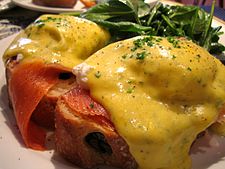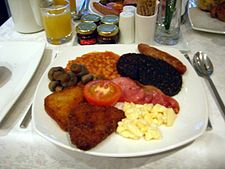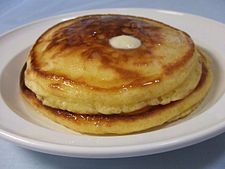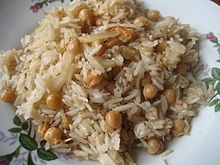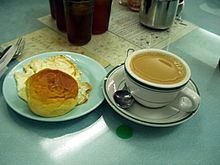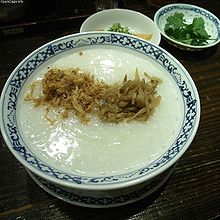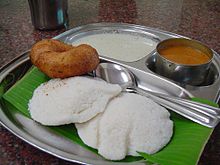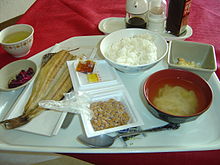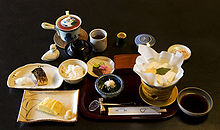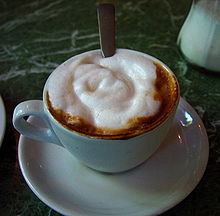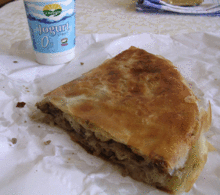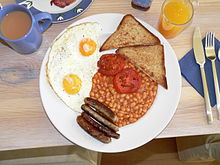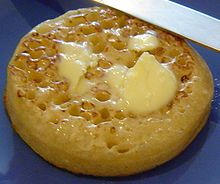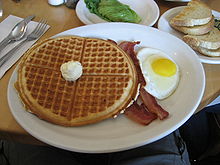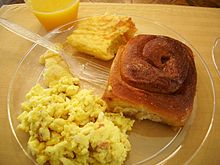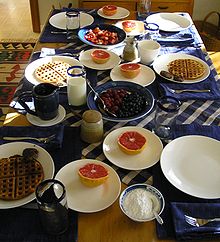- Breakfast
-
For other uses, see Breakfast (disambiguation).
Part of a series on Meals 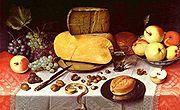
Common meals Breakfast · Brunch · Lunch · Tea · Dinner · Supper Components & courses Amuse-bouche · Appetizer · Cheese · Cocktails · Dessert · Drink · Entrée · Entremet · Fruit · Main course · Nuts · Salad · Side dish Related concepts Banquet · Buffet · Cuisine · Eating · Etiquette · Food · Global cuisines · Outline of cuisines · Snack A full English breakfast with scrambled eggs, sausage, black pudding, bacon, mushrooms, baked beans, hash browns, and half a tomato
Breakfast (literally meaning "breaking the fast" of the night) is the first meal taken after rising from a night's sleep, most often eaten in the early morning before undertaking the day's work.[1] Among English speakers, "breakfast" can be used to refer to this meal, or, less commonly, to refer to a meal composed of traditional breakfast foods (eggs, oatmeal, sausages, etc.) served at any time of day.
Breakfast foods vary widely from place to place, but often include a carbohydrate such as grains or cereals, fruit and/or vegetable, a protein food such as eggs, meat or fish, and a beverage such as tea, coffee or fruit juice. Coffee, tea, juice, breakfast cereals, pancakes, sausages, bacon, sweet breads, fresh fruit, vegetables, eggs, mushrooms, black pudding, baked beans, muffins, crumpets and toast with butter or margarine and/or jam or marmalade are common examples of breakfast foods, though a large range of preparations and ingredients are associated with breakfast globally.[2]
Nutritional experts have referred to breakfast as the most important meal of the day, citing studies that find that people who skip breakfast are disproportionately likely to have problems with concentration, metabolism, and weight.[3][4]
History
Breakfast has commonly been practiced worldwide and is a concept easily transferred between cultures, but there have been many regional interpretations over the years. In Medieval Europe, for instance, the basic format of meals differed from what is currently 'standard', in that only two meals were to be had; a heavy dinner at noon and a light supper, largely due to the influence of the Church.[clarification needed]
However, exceptions existed, most notably for children and the infirm, whom were "allowed" a small breakfast meal,[according to whom?] and many labourers, farmers, and other physical workers also took the meal despite criticism and social pressure on them not to,[according to whom?] and by the 15th century even the nobility had begun to ignore the rules and mores of polite society and took breakfast.[5]
The earliest[citation needed] appearance in print of the idea that "breakfast is the most important meal of the day" occurs in the novella The Metamorphosis, published in 1915 by Franz Kafka, which includes the line, "for Gregor's father, breakfast was the most important meal of the day". This is due to your body fasting for 6–9 hours the night prior, and one would need to break the fasting. Thus called break-fast.
Africa
Breakfast in Africa varies greatly from region to region.[6]
Egypt
The traditional Egyptian breakfast is ful medames served along with whole wheat bread,Falafel known in Egypt asطعمية and made with fava beans), and pickled vegetables. Fried or boiled eggs and various cheeses are also popular.
Ghana
The typical breakfast includes omelets; a very sweet and dense breadnot known as sugar bread; and tea. Porridge is occasionally eaten at home, while many people purchase their breakfasts from street vendors. A porridge called Tom Brown (a light brown porridge made from roasted maize flour) is also eaten for breakfast. In contemporary times, a local meal called waakye (rice cooked in beans) is very common. People prefer to buy waakye from street vendors just as they do other small meals.
Libya
The Libyan breakfast is typically composed of an assortment of dishes, served with freshly baked bread. Tuna, scrambled or boiled eggs, harissa (blended chillies with garlic, lemon, olive oil and salt), olive oil, dates and Bseesa (a local dish made with powdered oats, barley, sugar and other grains blended with olive oil). Common beverages include green tea with mint, coffee, milk and fruit juice. A speciality breakfast can be in the form of a sweet dish called "Aseeda" which is made with a sweet boiled dough which is beaten and shaped till it becomes a soft round oval shape. It is dressed generously with warm honey or date syrup.
Morocco
Breakfast typically includes Moroccan bread, local pastries, baguettes, and croissants with olive oil or argan oil, smen (or ghee), honey, jam and amlou (a dip made from toasted almonds, argan oil and honey). Also common are cheese, yogurt, harira, and bissara (a Moroccan fava bean puree). Common beverages include green tea with mint, coffee (including café au lait), warm milk, and fruit juice.
Nigeria
Nigeria has over 250 different ethnic groups,[7] with a corresponding variety of cuisines. For the Hausa of northern Nigeria, a typical breakfast consists of kosai (cakes made from ground beans which are then fried) or funkaso (wheat flour soaked for a day then fried and served with sugar). Both of these cakes can be served with porridge and sugar known as koko. For the south western Yoruba people (Ilé Yorùbá) one of the most common breakfasts is (ounjẹ árọ) is Ògì— a porridge made from corn, usually served with evaporated milk. Ògì is eaten with Acarajé (akara) or Moi moi. Both are made from ground bean paste; akara is fried in oil, and moi moi is wrapped in leaves or foil and then steamed. Ògì can also be steamed in leaves to harden it and eaten with akara or moi moi for breakfast. English tea or malta is served as a breakfast drink. Another popular option in southwest Nigeria is gari, which is eaten like a cereal. Gari, known in Brazil as farofa, is made from the root of cassava. For breakfast, it is soaked in water and sweetened with sugar.
Senegal
Breakfast typically includes coffee, with dried milk and abundant sugar, accompanied by baguette[8] with various spreads: Chocoleca, a Nutella equivalent made from peanuts; butter; or processed mild cheese. Fresh fruit, including mangoes and bananas, is often also part of a simple breakfast.
Uganda
Breakfasts vary by region. People often have a cup of tea with a variety of either warm or cold foods. In central Uganda, tea is prepared with milk and ginger, and it is served with a warm meal known locally as katogo. This is a combination of green cooking bananas (matooke) mixed either in a stew from beef or in sauce from vegetables such as beans. In some parts of northern Uganda, breakfast would consist of tea and boiled cassava.
Northern African coriender bread is a important breakfast item among Northern Africans.
Asia
Afghanistan
A typical breakfast would be omelette or boiled eggs, cake or biscuits, buttered toast, rice with koft'a (meat) or sabzi (vegetable). Drinks include black tea, or qaimaaq chai (green tea with milk and rose essence or cardamom seeds).
Bangladesh
Breakfast in the country is called Nashta. There are moderate regional variations in its composition, but the most common would typically consist of roti/chapati, aloo/shabji bhaji or aloo dam (dishes made primarily of potatoes and vegetables), chicken curry, daal (lentil curry), spicy egg omelet, and cha (tea). A heavier variant of breakfast would go on to include paratha, special roti/chapati, chital peetha (similar to a rice flour and lentil-based pancake), poori/luchi, or bakarkhani. On some occasions, rice dishes substitute the flatbread. Beef curry or Nihari (spicy curry of beef or mutton shank) would be likely to accompany. A lighter (and also less spicy) variant of breakfast would comprise chital peetha, bhapa peetha (steamed cake made with rice flour and molasses), milk, molasses, khejur rosh (date syrup), coconut, khoi (puffed wheat), and muri (puffed rice). Sweet dishes like halwa, firni (similar to rice pudding), jarda (colourful, sweet rice-based dish), shemai (sweet vermicilli) and doi (thick yogurt) are popular during breakfast. Seasonal fruits, fresh or juiced, serve as a refreshing complement to a predominantly spicy breakfast. Semi-fermented rice, regular or dried fish curry, vegetable, herbs and chilies can constitute a breakfast in many rural areas. English-influenced breakfast of cereal, milk, toast with butter and jam spread, and fried egg is common in urban areas.
Burma
A traditional Burmese breakfast in town and country alike is htamin jaw, fried rice with boiled peas (pè byouk), and yei nway jan (green tea) especially among the poor. Glutinous rice or kao hnyin is a popular alternative, steamed wrapped in banana leaf often with peas as kao hnyin baung served with a sprinkle of crushed and salted toasted sesame. Equally popular is the purple variety known as nga cheik cooked the same way and called nga cheik paung. Si damin is sticky rice cooked with turmeric and onions in peanut oil and served with crushed and salted toasted sesame and crispfried onions. Assorted fritters such as baya jaw (urad dal) go with all of them. Nan bya or naan (Indian-style flatbreads) again with pè byouk or simply buttered is served with Indian tea or coffee. It also goes very well with hseiksoup (mutton soup). Fried chapati, blistered like nan bya but crisp, with pè byouk and crisp fried onions is a popular alternative. Htat ta ya, lit. "a hundred layers", is flaky multilayered fried paratha served with either pè byouk or a sprinkle of sugar. Eeja gway (Chinese-style fried breadsticks or youtiao) with Indian tea or coffee is another favourite. Mohinga often available as an "all-day breakfast" in towns and cities, is rice vermicelli in fish broth kept on the boil with chickpea flour and/or crushed toasted rice, lemon grass, sliced banana stem, onions, garlic, ginger, pepper and fish paste and served with crisp fried onions, crushed dried chilli, coriander, fish sauce and lime. Add fritters such as split chickpea (pè jan jaw), urad dal (baya jaw) or gourd (bu jaw), boiled egg and fried fish cake (nga hpè jaw). The Rakhine Mont-de, is a lighter variant of Mohinga. It consists of thin rice noodles eaten with clear soup, made from boiled ngapi and lemon grass. Toasted fish flakes, from snakefish and green and red chili paste are also added, with seasoning. Rakhine Mont-de is also called ar-pu-shar-pu (literally "hot throat", "hot tongue") because of its heavy use of spicy ingredients. A salad version also exists. It is now available in many cities and towns across Burma.
Cambodia
In Cambodia, rice congee (babaw) is widely eaten for breakfast. Plain congee is typically eaten with salted eggs, pickled vegetables, or dried fish. Chicken congee, pig's blood congee, and seafood congee are also commonly eaten. Cambodians also enjoy rice served with sliced pork or chicken with pickled vegetables or a noodle dish (usually a noodle soup called khtieau). Caw (a pork or fish soup dish made with caramelized sugar) is also eaten with congee or rice for breakfast.
Korea
In South Korea, breakfast consists of components similar to other Korean meals:[9] a small plate of kimchi or several types of kimchi, a bowl of rice and a bowl of clear soup made with vegetables (radish, onion, seaweed green onion, cucumber, squash, any vegetable can be used) and enriched with stock made most commonly from meat, bones, shell fish or dried pollack or anchovies in the broth. Savory namul or vegetables cooked in a pan with oil and seasoned with salt and other flavorings can also be served as a nutritious alternative or acompaniment to fried or grilled fish. Western-style breakfasts consisting of sliced bread either plain or toasted in an electric toaster, jam and perhaps butter, coffee, washed and cut tomatoes and other fruits and vegetables, or eggs are also common.
Laos
In Laos, it is customary to eat soup for breakfast, as well as congee.
Nepal
Tea and milk are part of the daily breakfast routine, along with satu (powder of corn) or chiura (beaten rice) or some local cookies. The pattern of breakfast is different but bread, soup, vegetables, and chappati called puri tarkari are greatly included nowadays in most places. Dal, bhat and tarkari are the famous staple foods of Nepal.
Hong Kong
Traditional Chinese breakfasts in Hong Kong follow those in Canton. Also found are local interpretations of English breakfast and eastern Chinese breakfast fare. The long periods of British colonial rule and the influx of many refugees from Jiangsu and Zhejiang provinces and Shanghai around the end of the Chinese Civil War changed eating habits. In Hong Kong, cha chaan teng breakfasts might consist of Hong Kong-style milk tea, coffee, or yuan yang (half tea-coffee mix), served with bread (roll or toast), ham, and fried eggs (sunny-side up with 3 green peas on the side), and a bowl of macaroni in clear soup with shredded ham. The Taiwanese regard this local interpretation of the English breakfast as unique to Hong Kong. In upscale (upmarket) restaurants or hotels, however, standard English and Continental breakfasts are served.
Sri Lanka
The traditional breakfast includes usually fresh roti, pittu, string hoppers, hoppers, milk rice, appa, green gram or bread . These are usually eaten with sambol (coconut, maldive fish or seeni-onion fried with chili and sugar),with jaggery, plantains or curry (fish, meat or vegetable). Noodles and cereals such as cornflakes are relative newcomers in main cities. Sri Lankans also have a traditional soup-like drink called kanda. A typical everyday breakfast can simply consist of "brother bread" with dhal curry, sambol, butter and cheese or jam, plantain banana and tea.
Taiwan
The influx of mainland Chinese to the Taiwan in 1949 after the end of the Chinese Civil War changed breakfast habits. Breakfasts tend to be a mix of northern and eastern Chinese dishes and the traditional southeastern Chinese fare. This is more pronounced in cities with high proportions of people of mainland Han Chinese descent, such as Taipei. A typical Taiwan breakfast consists of you tiao (a fried breadstick), dou jiang (a warm, savory soybean soup), and dan bing (crisp scallion pancakes). The you tiao is dipped in the dou jiang, similar to how bread is dipped in soup.
Thailand
In the case of Thailand, a variety of different foods are served for breakfast since the country has opened to the eating cultures from many countries. Thai-Chinese people typically have congee/jook, boil-rice with fishes, pickles, dried shredded pork; dim-sum is also popular in some provinces, particularly in the south of Thailand. During rush hours in big cities, particularly Bangkok, people would have a fast and simple Western style breakfast, for example, bread, cornflakes, omelet, coffee and milk. Street eateries in Bangkok offer a wide range of food, such as sandwiches, grilled or fried pork with sticky rice, noodles, rice and Thai curries. Since there are so many kinds of food for breakfast, Thai people usually say that they would eat whatever they want for their breakfast.
China
Breakfasts vary greatly between different regions.
- Northern China breakfast fare typically includes steamed buns in different shapes (the stuffed ones are 'Bao Zi (buns)', the plain ones are called 'Man Tou' and those 'rolls' are sometimes called by those people living in a certain region as 'Hua (flower) Juan (roll)', grilled flat, round buns (Shao (grilled) Bing (biscuit)', with dòunǎi or dòujiāng (soya milk) or Chinese tea (served hot and plain, without lemon or milk).
- Central and eastern China, typified by Shanghai and the neighbouring Jiangsu, Zhejiang, and Anhui provinces, breakfasts are characterised by the combination of both northern and southern dishes. These may be stuffed rice rolls (粢飯) (a bit similar to Japanese sushi but much bigger in size), bean curd and cellophane noodles soup); plain rice porridge (粥) served with numerous side dishes, such as salted duck eggs, pickled vegetables, and thousand-year eggs; or sweetened or savoury soya milk served with grilled flat, round buns or yóutiáo (油條).
- Southeastern China, such as Fujian, breakfasts consist of rice porridge served with side dishes such as pickled vegetables and thousand-year eggs.
- Southern China, represented by Guangdong, breakfasts include rice porridge/congee prepared to a thicker consistency than those sold in Shanghai. Side dishes may or may not be served. Congee can be eaten with fried dough (油條/油炸鬼) or other kinds of deep-fried bakery products (in Chinese style) if it is plain, or not, as far as you like. In many cases, however, congee is prepared with any kind of ingredients as you can or cannot imagine, such as beef slices, shredded salted pork, minced meat, thousand-year eggs, fish, or sliced pig's liver and kidney, meatballs, frog, chicken, or even abalone. You can find not less than one hundred combinations on the menus of such congee restaurants (usually these are food stalls selling mainly congee, noodles and those Chinese deep-fried bakery products alone). Other breakfast items include rice noodle rolls ('Cheong Fun' 腸粉), fried noodles (sauteed noodles with bean sprouts, spring onions, soya sauce and sometimes some shredded pork, or even ham, etc.), jiānbǐng (thin crisp omelettes with fillings folded in), lúobogāo (turnip puddings) and 'rice dumpling' (wrapped in bamboo leaves, usually as a festive food during Dragon Boat Festival at around June every year). For Cantonese, the typical breakfasts (apart from the home-made congees) are dim sum breakfasts. Dim sum is often eaten at Cantonese restaurants, while nowadays, with its growing popularity and the advancement of technology, many different kinds of deep-frozen dim sums are available in supermarket, with most can be ready to serve just by re-heating it in a microwave oven for a few minutes.
India
India has a vast range of breakfast dishes with traditional fare varying widely by region:
- In West Bengal breakfast may include luchi/kochuri (stuffed luchis), puffed rice crisps with milk, jaggery and fruits. The luchi/kochuri are served with a vegetable curry or something sauteed. Semifermented rice (panta bhaath), which has a mild pungent flavour, is also eaten, sometimes with dal and chilies.
- South Indian states, Andhra Pradesh, Tamil Nadu, Karnataka and Kerala, in rural areas and farming communities especially, rice porridge (known as congee, kanji kanyi or ganji) is a traditional breakfast item. In other areas Kanji is served with various condiments such as spicy pickles, coconut chutney or curry the most popular and common breakfast items are most often served with chutneys (coconut, onion, chana dal or peanut chutnies) and/or Sambar and somekind of spicy powder called podi. This is usually accompanied with a tumbler of filter coffee. They include:
-
- Idly — Steamed rice and urad dal saucers
- Vada — deep-fried urad dal or chana dal batter with spicy seasoning
- Dosa — Rice and urad dal batter made into thin, round pancakes.There are several variations as well. While the most common is the plain dosa, it is not uncommon to come across variations such as Masala Dosa(stuffed with Potato), Rava Dosa(the traditional dosa batter with onions, semolins, green chillies etc.), Uttapam (a spicier version) and so on. Some food critics claim there are tens of ways of making this dosa.
- Upma — Mildly spicy porridge prepared with broken wheat, semolina or semiya
- Pongal — Mildly spicy rice porridge, considered a very comforting morning meal
- Chapati — flat bread prepared with durum wheat flour
- Poori — Deepfried puffed rounds prepared with durum wheat flour or maida
- Rotte (Roti): Flat bread prepared with millet (sorghum) flour, commonly served in rural households.
- Poha (batata poha , poha chutni): just flattened rice and coconut or a mixture of flattend rice and potato mixture, commonly served in mangalore area.
- In Kerala the traditional breakfast, praatal പ്രാതല്) includes puttu (പുട്ടു്) (eaten with kadala (കടല) (black chana curry) or ripe bananas (നേന്ത്രപ്പഴം), porotta (പൊറോട്ട) / pathiri (പത്തിരി) or orotti (ഒറോട്ടി) (eaten with chicken, mutton or vegetable curry), appam (അപ്പം) — paalappam, vellayappam, kallappam, idiyappam (ഇടിയപ്പം) or noolappam (നൂലപ്പം) — with egg curry (മുട്ടക്കറി) or vegetarian stew, kappa (കപ്പ) (tapioca) and meencurry / meenvaruttathu (tapioca and fish) and other popular breakfast items like idli (ഇഡ്ഡലി) and dosa (ദോശ) or masala dosa (മസാല ദോശ). Other common dishes include ada (അട) — ilayada, ottada — ariyappam, and uppumaavu (ഉപ്പുമാവു്).
- North India Hindu. The breakfast consists of stuffed paratha breads or unstuffed parathas (very dense but thin, circularly shaped flat breads) with fresh butter, cooked tatse vegetables, especially aloo sabzi. Puri and chholey are also a popular breakfast, along with rajma-chawal.
- North India Muslim. Especially in Delhi and Uttar Pradesh, this consists of shermal (a heavy but very soft sweet naan-type bread) and taftan (slightly sweet and salty variant of naan). Popular accompaniments include sweets like jalebi, halwa, and sweetened milk. Samosas, and a combination of jalebi with yogurt (dahi-jalebi), comprise stand-alone breakfast items in Uttar Pradesh and its surrounding parts. In Maharashtra, poha, upma, idli, thalipit, and shira (similar to kesaribath) is frequently eaten for breakfast.
- Gujarati breakfast items include haandvo, dhokla, sev-khamni, theplas (a form of paratha), bhaakhri and assorted hard and crisp masala puris with pickles. A dip for the theplas is also made by mixing pickle with yogurt. Tea is a staple item in breakfast.
- In Maharashtra also called as नाश्ता, poha, upma, idli, thalipit,Vadapav,Misal and shira (similar to kesaribath) is frequently eaten for breakfast.
Indonesia
A popular Indonesian breakfast is lontong sayur, a dish made of compressed rice with a spicy curry sauce and cooked vegetables, typically jackfruit, as well as mie (noodles), deep fried redskin peanuts, and kerupuk (prawn crackers). Optional accompaniments include boiled egg (sometimes in a spicy sambal) and perkedel (deep fried potato cakes). A quantity of the dish will be prepared prior to sale at a food cart or warung, and will be served at room temperature and not reheated during sale.
In homes, nasi goreng is the most popular breakfast dish. Unlike lontong however, nasi goreng is also eaten for lunch and dinner, making it the most reliable kind of dish. Lontong also needs far more preparation and would generally be eaten at a local warung or food cart, whereas nasi goreng is very easy to make, yet really tasty, and usually accompanied with shrimp and egg or any suitable accompaniment. Due to its popularity, nasi goreng is sold in many warungs throughout Indonesia and can be found in nearly all hotels in Indonesia.
Another popular breakfast is bubur ayam, which is rice porridge. It is usually served hot, with Cakwe (Chinese fried bread stick), spring onion leaves, pieces of chicken slices, some chilli sauce, and sweet soy sauce. Like nasi goreng, this dish can be served for lunch and dinner as well. It is also easy to make.
Among college students (especially for those who rent houses) mie instan (instant noodles) are popular, both the fried and soup variety. A popular brand is indomie, or its product, pop mie (instant noodles served in a cup). Its preparation is simple and takes around 5 to 10 minutes (especially pop mie, where only hot water is added). Such preparation makes it an easy breakfast for students because they need to attend college in the morning. Like the above, it can be served for lunch and dinner.
In addition to these, Indonesians often simply eat the leftovers from the previous evening's dinner, such as curry, with plain rice. The high tropical temperatures, high degree of humidity and widespread lack of refrigeration make it prudent to eat food while it is still relatively fresh. If lacking such leftovers, a basic dish such as fried ikan teri (dried fish), or some kind of fried egg, again served with plain rice, would be common.
Japan
A traditional Japanese breakfast is based on rice, seafood, and fermented foods, which do not differ substantially from dishes eaten at other meals in Japanese cuisine. An exception is nattō (a type of fermented soybeans), which is most popularly eaten for breakfast. A typical Japanese restaurant breakfast presentation would be[citation needed] miso soup, rice with nori or other garnishes, nattō, rice porridge, grilled fish, raw egg, and a pickled vegetable. The influence of Japanese travelers has made this traditional breakfast a standard option on the menus of many upscale hotels worldwide.[citation needed] It is common in Japanese households to include leftover items from the last evening's dinner in the next day's breakfast. Western breakfast foods such as toast and boiled or fried eggs are also common, and cereals are becoming popular. The typical[citation needed] breakfast beverage is green tea (traditional).
Malaysia and Singapore
In Malaysia, breakfast sometimes consists of a popular Malay food called nasi lemak. Other food such as roti canai (known as roti prata in Singapore), kaya toast, half boiled eggs and wonton noodles are also among the favorites. In East Malaysia, glutinous rice is eaten as breakfast. Malaysian Chinese from the town of Klang, which is famous for its bak kut teh, frequently eat this herbed pork rib soup dish for breakfast. In other parts of Malaysia and Singapore, however, it is more commonly eaten at other meals.
A typical Singapore breakfast can be relatively cosmopolitan, with a variety of food choices from various cultures. The traditional local breakfast is kaya toast with half-boiled eggs (served with soy sauce and pepper), and coffee/tea. Other common local breakfast foods include fried noodles or vermicelli (served with side dishes like fried eggs, vegetables, luncheon meat, hotdogs, meatballs, cheese, fish cake or tofu), mee goreng (Malay version of fried noodles, albeit spicier), nasi lemak, curry puffs, kueh-kueh (Malay cakes) or sandwiches for those on the move. There are other local favourites like bean curd, sweet soups like black glutinous rice porridge and green/red bean soup. North American and European-style breakfasts are also popular, such as breads and cereals, or breakfasts from fast-food or coffee chains.
Pakistan
Breakfast is called Nashta. The traditional breakfast in Pakistan is usually a heavy meal. There are several dishes:
- Halva puri cholay or halva puri, for short, consists of two separate dishes, halva, a sweet made from semolina, and aloo cholay, a spicy chickpea-and-potato curry eaten with puri, a small circular deep-fried flat bread.
- Egg khagina or Anday ka Khagina is a popular breakfast dish with families, particularly on weekends. Its preparation and appearance are similar to scrambled eggs, but includes the addition of vegetables, herbs and spices and is traditionally accompanied by Pakistani flat breads such as roti (chapatti) or paratha.
- Siri paya is eaten with naan (siri paya is a stew made of cow, goat or lamb's brain and feet. "Siri" means the head of the animal and "paya" its feet. It is considered a delicacy.
- Nihari is a stew made from beef or lamb shanks, and eaten with naan.
- Lassi is a drink made from milk and yogurt, served in sweet, and rarely, in salty flavor.
Otherwise, parathas is often the default option eaten for breakfast; they may be stuffed with vegetables, chicken, beef or mutton mince. Tea is served with breakfast.
In cities and other urban areas, eggs and toast with butter and jam are also popular. Another breakfast popular in urban areas in Pakistan is tea with buttered rusks and fresh orange juice. In Karachi and Hyderabad, where Urdu-speaking migrants from North India are in majority, Shermal and Taftan are a popular breakfast item.
Philippines
Breakfast is known in the Philippines as agahan or almusal. Philippine breakfasts vary from moderate to very heavy, depending on tradition. In some areas, even leftover lechón (roast suckling pig) is eaten with fried rice.
Rice is a predominant staple in the Philippines. As such, a favourite traditional breakfast has fried rice called sinangag. Usually, this is made of leftover rice from the previous dinner (so nothing is wasted, as well as because this yields a firm and "tossed" texture, which is preferred over sticky), and fried with salt and garlic cloves. This is then combined with fried or scrambled eggs, and a choice of breakfast meat: beef tapa (pan-seared steak), pork tocino (sweet cured pork), longganisa (sausage), dried, smoked fish (such as tuyo), canned sardines, sauteed corned beef, or adobo, sometimes with Western-style baked beans, sliced tomatoes and a local pickled papaya shreds (achara) on the side. Alternatively, a cheese-topped breakfast pastry called an ensaymada (a colonial relative of the Mallorcan ensaimada; a brioche) is also eaten, usually with hot chocolate, as is pan de sal (Philippine breakfast roll) filled with a buffalo milk white cheese (kesong puti), and local barako coffee.
Western-style breakfasts such as pancakes, French toast, and porridge are also eaten at home, as are cold breakfast cereals which are popular with children. There is also a breakfast known as tapsilog, which is a combination of tapa, sinangag and itlog (egg). Finally, there is champorado, a local chocolate sticky rice porridge, often served with a side dish of crisp-fried sun-dried fish (danggit or tuyo) — an unusual, though authentically Filipino combination.
In the early mornings, hawkers also sell rice porridge (lugaw/goto), and noodle soups (such as mami, lomi, and batchoy) from stalls to those on their way to work. Bakeries also open early for those purchasing pandesal to eat at home, as well as for people who eat breakfast "on the go". Tahos are also a popular accompaniment to breakfast, especially with children, and these are bought from vendors who carry them.
Vietnam
There are multiple breakfast menu options across Vietnam, and usually the urban household will buy this from vendors rather than make it (rural families usually have rice and leftovers warmed up for breakfast). Breakfast can be quite hearty, depending on whether one chooses to top their meal with a meat roll or pastries. Typical noodle breakfast dishes in Vietnam (which are usually served with a loaf of bread to dip in the soup) include phở (Vietnamese beef or chicken soup based rice noodle), hu tieu (rice noodles in a pork based soup), bún bò Huế (spicy Hue style beef soup based noodles), bún riêu (crab soup based vermicelli noodles) or Mì Quảng (prawn and pork rice noodles). Bánh cuốn (crêpe-like roll made from thin, wide sheets of rice flour filled with ground pork, minced wood ear mushroom, and other ingredients, including meat loaves and sauce), bánh bao (savoury meat buns or sweet bean buns), bánh mì (Vietnamese cold cut meat loaf breads), bánh mì ốp la[10] (Vietnamese French bread with sunnyside-up eggs). The term ốp la is from the French oeuf au plat (which may be served with a hot meat ball soup)), xôi (or glutinous rice, either savoury or sweet), boiled eggs or congee (similar to the southern Chinese), are common breakfast meals in Vietnam. Often, the Vietnamese will drink Vietnamese iced coffee, tea, juice, or soy milk to complete their breakfasts.
Australia and New Zealand
In New Zealand and Australia, the typical breakfast strongly resembles breakfast in other English-speaking countries. Owing to the warm weather in some parts of Australia, breakfast is generally light. The light breakfast consists of cereals, toast, fruit, and fruit juices, rather than cooked items. However, people in these countries may also enjoy a heavy breakfast with fried bacon, eggs, mushrooms, sausage, tomatoes and toast, with tea or coffee and juice (similar to the full English breakfast). Some other typical meals include pancakes (which are more common in Australia than crêpes), porridge, yogurt, and hash browns. A meal popular at gala horse racing events is a "chicken and champagne breakfast" typically consisting of roast chicken, an egg dish, fresh fruits, breads, condiments and a glass of champagne, often as a picnic. In summer, a New Zealand breakfast will typically consist of some variation on toast, cereal, juice and fruit. In winter, many New Zealanders prefer porridge or Weet-Bix with hot milk. Some New Zealanders will create a full cooked breakfast after the English tradition — generally bacon and eggs, fried tomatoes, fried mushrooms, and toast. American-type breakfasts (pancakes etc.) are becoming more common in New Zealand. These are usually purchased from a restaurant for weekend brunch.
Europe
As a general rule,[citation needed] traditional breakfasts are less substantial and less elaborate in the warmer, more southern countries bordering the Mediterranean, while breakfasts are traditionally larger, with a greater variety of dishes and greater prevalence of hot dishes in the cooler northern and central European countries.[citation needed]
Hotels and other types of lodging in Europe typically include breakfast in their rates, and in many cases, especially in larger hotels, it is served as a buffet. Specific items will vary from country to country, depending on local breakfast tastes and habits. In Germany, Austria, and Switzerland, for example, cold cuts (luncheon meats), cheese, yoghurt, prepared fruit, butter, croissants, breads, and rolls are served. Sometimes foods belonging to the English breakfast eggs, sausages, tomatoes (fresh, grilled or canned), bacon can occasionally be found as part of the buffet.
Continental breakfast
Continental breakfast is a meal based on light mainland European breakfast traditions. It is a light meal meant to satisfy one until lunch. A typical continental breakfast consists of coffee and milk (often mixed as cappuccino or latte) or hot chocolate with a variety of sweet cakes such as waffles/pancakes, brioche and starchy foods such as croissants, often with a sweet jam, cream, or chocolate filling. It is often served with juice. The continental breakfast may also include sliced cold meats, such as salami or ham, yogurt or cereal, or a slice of cheese. Some countries of Europe, such as the Netherlands and those in Scandinavia, add fruit and cheese to the bread menu and occasionally a boiled egg or a small serving of salami.
The continental breakfast concept is not limited to Europe and is often served throughout the world in hotel chains. The term itself is of British origin. "The continent" in Britain refers to the countries of continental Europe. A "continental breakfast" thus denotes the type of lighter meal served in continental Europe, as opposed to the "full" English breakfast.
Northern Europe
Belgium
A typical Belgian breakfast is like that of its northern neighbor, the Netherlands. Most Belgians do not eat their most famous food for breakfast, Belgian waffles, which are traditionally sold in tourist areas of large cities, and are eaten as a snack. The breakfast in Belgium consists of breads, toasted or untoasted, with several marmalades, jams, and nut spreads, such as Nutella or just with a bar of chocolate. Other common toppings include sliced meats and cheeses. Pastries and croissants may be served on Sundays, but are mostly not eaten on weekdays. Belgians often enjoy coffee, tea, hot chocolate, milk, water, or fresh juice with breakfast.
Denmark
A typical breakfast in Denmark consists of cereals or bread, bread rolls (rundstykker), cheeses, fruit preserves (marmelade, usually made from berries or citrus fruits) and other toppings, accompanied by skimmed milk, tea or coffee. Weekends or festive occasions may call for Danish pastries (wienerbrød) or a bitters, such as Gammel Dansk.[11]
Finland
Breakfast usually consists of open sandwiches. The sandwich is often buttered (with margarine), with toppings such as hard cheese or cold cuts. Finns usually don't have sweets on their breads such as jam (like the French and the Americans), or chocolate (like the Danes).[citation needed] Sour milk products such as yogurt or viili are also common breakfast foods, usually served in a bowl with cereals such as corn flakes, muesli, and sometimes with sugar, fruit or jam. A third food that is commonly eaten at breakfast is porridge (puuro), often made of rolled oats, and eaten with a pat of butter (voisilmä, lit. "butter eye") and/or with milk, fruit or jam, especially the sort made of raspberries or strawberries (sometimes lingonberries). Drinks are milk, juice, tea, or coffee.
Norway
Breakfasts in other parts of Norway can be quite ample. Fish, cheese, eggs, bacon, hot and cold cereals, breads, potatoes, and fruits are all eaten in various combinations, along with juices, coffee, and tea. or kulturmelk (Norway), a cultured milk similar to buttermilk or yogurt is often eaten with cereals. Whole-grain porridges with regular milk or butter are popular. Interestingly enough, the word for breakfast in the Swedish language/Norwegian language ("frukost" = early meal) means "lunch" in Danish. The Danish language word for breakfast is "morgenmad" (morning meal).
Latvia
A typical Latvian breakfast usually consists of open sandwiches with toppings made of vegetables, fish, eggs or cheese. Same as in Finland it is often buttered with margarine. Curd mixed with vegetables and salt as well as other sour milk products are very popular as well. Very often light oat porridge is eaten too. In general light, sour and salty tasting food is common for morning meal. Latvians usually drink coffee for breakfast. The Latvian word for breakfast is "brokastis".
Netherlands
The Dutch typically eat sliced bread with three choices of toppings: dairy products (numerous variations of cheese), a variety of cured and sliced meats, or sweet or semi-sweet products such as jam, peanut butter or chocolate toppings (hagelslag (chocolate sprinkles), chocoladevlokken (chocolate flakes) and chocolate spread). Some typical, but less common products are apple syrup, honey, stroop (lesser known as bebogeen, a very sweet caramel topping made from sugar beets) and kokosbrood (a coconut product that is served thinly sliced like sliced cheese; also known as Cocosbread). Breakfast cereals and muesli are also popular, served with milk or yoghurt. Tea, drip coffee, milk, and juice are the most popular breakfast beverages. Breakfast may also include (for instance on Sundays) boiled eggs, raisin bread, pumpernickel, ontbijtkoek or croissants.
Sweden
Breakfast in Sweden is generally a sandwich made of a large amount of different types of soft bread or crisp bread, cold cuts, caviar, cheese, cottage cheese, cream cheese, goat cheese, eggs, scrambled or boiled, tomatoes or cucumber, or a toast with marmalade or maybe honey, juices, coffee, hot chocolate or tea. Breakfast cereals or muesli with milk, yoghurt or filmjölk, currants and fruits are popular or warm whole-grain porridge with milk and jam, (for example lingonberry jam). Pâté (leverpastej) with pickles, blueberry-soup (blåbärssoppa) and rose hip soup is also possible sometimes for breakfast.
Central and eastern Europe
Germany & Austria
The typical German breakfast consists of bread rolls, butter, jam, ham, soft-boiled eggs and coffee although breakfast cereals or muesli have also become popular. Regional variation is significant, both in the amount of food and the offerings — cheeses, cold cuts, meat spreads, yogurt, granola and fruit (fresh or stewed) may appear, as well as eggs cooked to order (usually at smaller hotels or bed-and-breakfasts). A second breakfast is traditional in parts of Germany, notably Bavaria (there also called Brotzeit, literally "bread time").
Hungary
Hungarians usually have a large breakfast. It consists of bread, bread rolls or crescent-shaped bread (kifli), toast, pastries with different fillings (sweet and salty as well), butter, jam or honey, eggs in different forms (fried/scrambled/omelette, etc.), salami, cold cuts, cheeses, hot dogs with mustard, tea, coffee or milk. Fruit juice in the morning is not that usual, hot drinks are more common. Hungarians sometimes have rice pudding called tejberizs or cream of wheat tejbegríz, usually eaten with cocoa powder or cinnamon sugar. Lecsó made from tomatoes and green peppers can sometimes be a breakfast meal as well, mainly in the summer.
Poland
In Poland, a traditional, weekend breakfast may consist of soft boiled, scrambled or fried eggs, or curd cheese with herbs (twarozek), sandwiches or "milk soup" — cereals with milk or in some regions milk with broken bread; regional alternatives include pancakes, salads or sandwiches with various pastes (fish paste, egg paste, etc.) Black pudding or sausage is sometimes eaten, usually by itself. Modern breakfast consists of a meat, cheese or jam sandwich, with coffee (roasted grain beverage is still popular), tea, kefir or soured milk, or juice as a beverage. Second breakfast, which replaces lunch at work, is similar or identical to the actual breakfast.
Romania
The traditional Romanian breakfast consists of bread, cold plates such as mortadella and cheese, feta cheese, cucumber, tomatoes and eggs prepared as an omelette or sunny side up. Also, black coffee or tea usually are served. In addition, natural juice or yogurt are always[citation needed] taken in as an option.
Switzerland
Swiss breakfasts are often similar to those eaten in neighboring countries. A notable breakfast food of Swiss origin, now found throughout Europe, is muesli.
Russia
Given Russia's generally cold climate, breakfasts tend to be substantial. Breakfast, or zavtrak as it is called in Russia, may consist of hot oatmeal or kasha, eggs, cheese, cured meats or sausage, rye breads with butter (butterbrods), and coffee or tea.
Southern/Eastern Europe
France
In France a typical domestic breakfast will consist of cups of coffee, often café au lait, or hot chocolate, usually served in big bowls, accompanied by a glass of orange or grapefruit juice. The main food consists of sweet products such as tartines (slices of baguette or other breads spread with butter, jam or chocolate paste), sometimes dunked in the hot drink. Brioches and other pastries such as croissants, pains au chocolat and pains aux raisins are also traditional. Other products such as breakfast cereals, fruit compote, fromage blanc, and yogurt are becoming increasingly common as part of the meal. A typical French breakfast does not include any savory product.
Greece
Home breakfasts in Greece include bread with butter, honey or marmalade with coffee or milk. Breakfast cereals are also eaten. Children also eat nutella type cream on bread. No breakfast at all is common[12]. Various kinds of savoury pastry (Tyropita, spanakopita, and bougatsa) are eaten for breakfast in some areas of Northern Greece, also by those eating out, usually accompanied with Greek coffee or Frappé coffee. Traditional Greek breakfast (hot milk, fresh bread, butter and honey, or yoghurt) was also available in special "milk shops" (in Greek Galaktopoleia - Γαλακτοπωλεία [2]). Milk shops were phased out between 1970 and 1990 - there are very few left, one is in Athens[13] and some in small towns.
Serbia
In Serbia domestic breakfast may include: eggs in different forms (e.g. omelet with bacon, onion and feta cheese), canned fish or opened sandwiches with prosciutto or ham, feta cheese and salad (e.g. pickles). Different types of pies and pastry with various filings (e.g. Proja, Gibanica, Burek) are also served as the main dish. Yogurt and coffee are preferred breakfast drinks. In the past it was a custom to drink Sljivovica before breakfast and after that Slatko with water. One of the traditional breakfasts consists of Proja, bacon, Sljivovica and garlic.
Bulgaria, Bosnia, Montenegro, Macedonia
Breakfast usually consists of various kinds of savory or sweet pastry, with cheese, meat or jam filling. The most typical breakfast consists of two slices of burek and a glass of ayran. Breakfast also often consists of open sandwiches. The sandwich is buttered (with margarine), with toppings such as prosciutto and yellow cheese.
Croatia
In Croatia the base is a continental breakfast with a variety of pastries with or without fillings (marmelade, chocolate, cheese, ham, nuts, poppy) and fermented milk products (yoghurt, soured milk, soured cream). Cold cuts, such as prosciutto, ham, salami, kulen, bacon, and various cheeses, are also very liked. Also, fried eggs or omelet and Vienna sausage with mayonnaise, mustard or ajvar are very often consumed. In continental parts you can easily find traditional sir i vrhnje (cottage cheese with soured cream and some spices). Coffee is much more preferred than tea (and it is mostly herbal tea).
Slovenia
Slovenes do not have typical slovenian breakfast, except white coffee with bread.
Turkey
In Turkey, breakfast consists of fresh white sourdough bread, white cheese (feta), yellow cheese (kaşar), a wide variety of jam, fresh tomatoes, cucumbers, black and/or green olives, butter, honey, clotted water buffalo cream (kaymak) preserves, sujuk, salami and a boiled egg — all accompanied by hot black tea in small tulip-shaped glasses. Breakfasts can be very elaborate for company or on weekends, and may include a variety of breads, pastries, and spreads, and several fresh fruits and vegetables in season, but the essential breakfast ingredients for almost every Turk on a daily basis are bread, cheese, jam, olives, and tea.
Italy
As the other italian meals the breakfast is different depending on the region. Generally breakfast in Italy is simply caffè latte (hot coffee with milk) with bread or rolls, butter, and jam — known as prima colazione or just colazione. Fette biscottate (a cookie-like hard bread often eaten with butter and jam) and biscotti (cookies) are commonly eaten. Children drink hot chocolate, plain milk, or hot milk with very little coffee. If breakfast is eaten in a bar (coffee shop), it is composed of cappuccino e brioche (frothed hot milk with coffee, and a pastry), very common is cornetto (italian for croissant). In Rome and Venice is very common to eat a tramezzino for breakfast (a white bread sandwich filled with tuna fish, mayo and tomato, boiled eggs mayo and tomato or ham and mozzarella and then toasted. Occasionally Italians, especially children, have a quick breakfast snack during the morning (typically a panino, or bread roll). In Sicily breakfast depends on the season, as during spring time and especially summer time it's very common to eat granita and brioscia (a sweet milk bread roll) while in autumn and winter is very common to eat typical sweets like iris (a deep fried chocolate pastry) or a cannolo or salted food like arancini or a baked bread bun filled with tomato, ham and mozzarella (cartucciata) or a puff pastry filled with tomato sauce, ham, mozzarella and onion (cipollina).
Malta
On the island of Malta, breakfast integrates both British and continental elements. Usually the Maltese start their day with a bowl of cereal mixed with milk, sometimes with a cup of coffee or tea. Marmalade/jams or even chocolate spreads are also common on bread or toast. Today cereal bars are also becoming a common type of breakfast on the island. The traditional English breakfast of eggs, sausages and fried bacon is also popular among the Maltese, especially on Sundays, due to the strong British influence on the island. Hotels usually serve both a continental as well as a full English breakfast. Prayers are often said before breakfast in order to bless the meal, but their religious deities are unable to save the populace from the high (HDL) cholesterol levels resulting in heavily fried foods.
Spain
In Central Spain the traditional breakfast is chocolate con churros — hot chocolate with Spanish-style fritters, which are extruded sticks of doughnut-like dough with a star-shaped profile. The chocolate drink is made very thick and sweet. In Madrid, churros are somewhat smaller and shaped like a charity ribbon. This meal is normally served in cafeterias. At home people usually have coffee or Cola Cao, juice, and either toast, cereal or a pastry. In the South and West it is more common to replace the "sandwich" toast with a slice of bigger bread and a topping of olive oil and salt, tomato and olive oil, butter, jam, pâté, jamón serrano (cured ham), and other options like sobrasada (a raw cured spiced sausage that is easy to spread), and in Andalucia, pringá. Coffee with milk is the most popular choice among the wide selection of coffee variants (usually the main variations are the proportion of milk and coffee, and the size and/or type of recipient). Freshly squeezed orange juice is widely available in most places, either as an alternative to the hot beverage or as a supplement. Traditionally the breakfast was not larger than these two items, because usually in late morning there was a break known as almuerzo when people had a bocadillo (Spanish sandwich). Nowadays the trend is towards a heavier breakfast - "almuerzo" being reserved only for people who do heavy physical work. Sometimes, toast is replaced with galletas (a type of cookie made with flour, sugar, oil and vanilla flavour), magdalenas (a Spanish version of the French madeleine made with oil instead of butter), or buns.
Portugal
A Portuguese pequeno-almoço comes in two varieties: one eaten running to work and another, more time-consuming one, more common on the weekends. When rushed in the morning, a cup of yogurt, milk, coffee or both and some bread with butter, cheese or jam suffices. Given the time, additions include orange juice, croissants, different kinds of pastry, and/or cereal.
United Kingdom and Ireland
Traditionally, people in the United Kingdom and Ireland have enjoyed a substantial hot meal for breakfast, featuring eggs, bacon, and sausages, accompanied by toast and tea or coffee. These items are sometimes eaten separately on morning rolls. In Britain, this was traditionally known as a full English breakfast, though there are also Scottish and Welsh variations (e.g. Scottish breakfasts often include haggis, black pudding and potato scones). Many other items (for example kedgeree, grilled or fried tomatoes,grilled sheep kidneys, black pudding or white pudding, baked beans, fried sliced bread, various types of fried potatoes and mushrooms) may be included, depending on taste and location, and pure fruit juice is sometimes added as a beverage in addition to tea or coffee. Today, this dish remains popular, but is not usually served at breakfast time during the week. Many people instead reserve the full cooked breakfast for weekends, or go to a café or pub for it at the weekend. A full breakfast is also a meal available any time at many cafés and greasy spoons. It is also served at hotels, where it can be quite substantial in size and variety. The author Somerset Maugham once quipped "the only way to eat well in England is to have breakfast three times a day." This is sometimes quoted as the origin of the term, and indeed meal, all-day breakfast.[citation needed]. Breakfast cereals remain a very popular food for breakfast in the United Kingdom, and are often eaten before the cooked breakfast components, and sometimes, people will merely have a bowl of cereal and some drinks for breakfast.
Another popular breakfast food in Scotland is the kipper, a type of salted, smoked herring that is then grilled or fried. A traditional Scottish Island breakfast are kippers or smoked haddock boiled in milk, and served hot.
In Northern Ireland they have their own take on the full cooked breakfast known as an Ulster Fry which includes sausages, bacon and eggs of an English breakfast but the hash browns beans and black pudding are replaced with a variety of fried breads including soda bread, potato bread and pancakes.
This traditional cooked breakfast has largely been replaced by simple, light foods mainly eaten cold: fruit, yogurt, packaged cereal with cold milk, and toast with a variety of spreads such as butter, jam, marmalade, lemon curd, Marmite, or peanut butter. Boiled eggs with soldiers are also a popular breakfast meal in the UK, although like the full English breakfast, they are mainly eaten at the weekend. In fact, eggs are quite popular as breakfast foods in general in the United Kingdom, and these may be eaten in a variety of ways - they may be eaten as boiled eggs, poached eggs, scrambled eggs or fried eggs. They may even be cooked as pancakes at Shrove Tuesday. Porridge is a traditional breakfast in Scotland as well as the rest of Britain in the winter months. In most British hotels, this breakfast is included in the room rate.[citation needed]
In Scotland traditional dishes include porridge, oatcakes with marmalade, potato scones, and black pudding. Potato scones are descended from Ireland and consist of mashed potato mixed with flour to create a type of scone. Black pudding is made from animal meat and blood.
Latin America
Latin American breakfasts feature many items seen in North American and continental European breakfasts in regional variations, according to their own culture.
In northern South America, maize-based breads, such as tortillas or arepas, may dominate or be augmented with wheat breads or pastries. Caffè, caffè e latte, chocolate, and tea are common beverages.
Argentina and Uruguay
In Argentina and Uruguay, breakfast consists mainly of espresso coffee, café con leche (coffee with milk), tea (with or without milk) or yerba mate. Other drinks include orange juice (specially in summer) and chocolate milk (mostly for childrens). These are usually accompanied with croissants(sometimes they are filled with hot or fresh cheesse and ham), brioches, facturas (pastries of German origin), filled churros, French bread with jam or dulce de leche and butter, grilled sandwiches of ham and cheese known as tostados, cereals and sweet cookies or crackers.
Brazil
Brazilians use the term café-da-manhã (morning coffee) or, less often, desjejum (des-, un + jejum, fast, fasting) to refer to breakfast. Black coffee, cow milk, yogurt and white cheese are quite popular, and so are fruit juices (especially orange, guava, mango, cashew and passion fruit). The coffee or juice accompanies bread rolls or sliced bread with jam or butter, grilled sandwiches of ham and cheese called misto-quente, slices of cake such as corn cake, orange cake and carrot cake. As for children, the most popular are sweet cookies or crackers with jam, toasts with fruit compote called tostadinha or torrada com geléia/compota accompanying chocolate milk or hot chocolate,"mingau", a hot porridge made with cow's milk, corn starch, sugar and vanilla with cinnamon sprinkled on top, as well as cornflakes or sucrilhos (frosted flakes) with milk. Morning meals are different in the various regions of Brazil. In the Northeastern states, it is common to find tapioca, a crêpe made of manioc flour, usually served with butter, cheese, coconut, or other fillings. It is also common to find cuscuz, a kind of bread made with corn flour and steam-cooked. In the Southern states, adults use to drink a steaming yerba mate infusion in a typical gourd, called chimarrão. The cold version is called tereré.
Chile
In Chile, breakfast is a light meal consisting of milk, coffee or tea, juice (typically orange), and two types of bread: marraqueta and hallulla, or toasts. They are accompanied with marmalade, manjar (dulce de leche), butter, cheese, ham, margerine, eggs, avocado, cream or jelly.
Costa Rica
In Costa Rica breakfast is traditionally Gallo Pinto which includes black beans and rice. Some people may add natilla (sour cream), Salsa Lizano (a sauce commonly used in Costa Rican cuisine) and a corn tortilla. Black coffee or coffee with milk are the preferred beverages, although orange juice is also common. Another traditional drink is "aguadulce", made from sugar cane panela which is boiled in water or milk. Side dishes may include avocado, fried ripe plantain, ham or some type of cold meat like sausages or salchichón, cheese, bread, eggs, etc.
Colombia
In Colombia there are various breakfast staples. In the Cundinamarca region people eat changua: a soup of milk, scallions, and cheese. In the Tolima region, a tamal tolimense is eaten in the company of hot chocolate and arepas. Tamales tolimenses are made with rice, dry legumes, beef, chicken and pork, egg, potato, and seasonings, covered with a maize dough, cooked while wrapped in a banana leaf. In Antioquia the usual fare includes arepa (arepa antioqueña, a typically home-made corn bread), with either cheese, fried eggs, or fried meat as well as hot chocolate as drink.
Cuba
Breakfast in urban areas traditionally consisted of café con leche that was sweetened and included a pinch of salt. Toasted buttered Cuban bread, cut into lengths, was dunked in the coffee. In rural Cuba, farmers ate roasted pork, beans and white rice, café con leche and cuajada sweetened with caramel.[14]
Dominican Republic
In the Dominican Republic, the main dish for breakfast is called mangu (mashing boiled plantains). It is prepared with ground plantain mixed with butter and is usually eaten with salami, fried cheese, eggs (fried eggs or scrambled eggs). This dish is usually accompanied by cafe con leche, hot chocolate, or juice. Another main breakfast dish is the sandwich, prepared with cheese, ham, salami, or scrambled eggs. This is often accompanied with coffee, hot chocolate or juice. To make this particular sandwich the Dominican people use a bread called pan de agua (water bread—a simple bread made with water, flour, yeast, and salt). Other kinds of bread are also used to make this simple meal.
Ecuador
In Ecuador breakfast depends on the region it is served. Along the Pacific Coast (litoral), breakfast mainly consists of strong black coffee brewed in a special little aluminium pot (café de olla), fried plantain and white hard cheese made locally. It can include also an omelette and fresh fruit juices. In the highlands (Sierra), breakfast may include some black coffee or herbal teas (infusiones) with some fresh bread rolls, and scrambled eggs.
Guatemala
In Guatemala they eat scrambled eggs with frijoles (beans) and tortillas with some cheese, fried banana and sometimes chirmol (tomato sauce with condiments). Also, depends of the region, the Guatemalan people eat Paches (like a "tamal" but made from potaoes, pork or chicken, hot chile), Tamales (made from corn dough, spicy red sause, pork or chicken. Everybody likes drink coffee (boiled coffee), atol (hot beberage from oats, corn or dough).
Mexico
In the past, when Mexico's population was predominantly rural and agricultural, breakfast tradition included hot beverages and breads at dawn, and a heavier mid-morning desayuno, consisting of an egg dish (such as huevos rancheros), chilaquiles, meats, beans, tortillas, pastries, and fruits. Commercial cereals are widely consumed now. Today, desayuno generally means "breakfast," and the Mexican breakfast may be the lighter or heavier version depending on personal taste or occasion. Usually, workday breakfasts differ from weekend or leisure day breakfasts in the amount and types of foods. Restaurants and hotels serve mainly buffet-style breakfasts with a variety of foods, oftentimes including "quesadillas" of various fillings, scrambled eggs, refried beans, chilaquiles, fruits and cereals. Menudo, a tripe stew considered a folk remedy for a hangover, has become a breakfast dish as well as one eaten at other meals. As with other large countries, breakfast in Mexico differs according to the region. In the north it is common to have salchicha con huevo (scrambled eggs with sausage) or machaca con huevo (scrambled eggs with beef jerky, in some places also called machacado), and wheat tortillas. In the central and southern regions of the country, corn tortillas are commonly consumed. Most breakfast dishes in the state of Veracruz are called antojitos (this word can be used for other meals), which consist of pastries made with corn flour and tend to be quite fatty. The most common antojitos are picadas (or pellizcadas, a tortilla with a sauce, onion and fresh cheese topping) and empanadas (tortillas filled with an ingredient like cheese, chicken or huitlacoche); in the northwest birria (beef or goat stew) and barbacoa (steamed beef or lamb) are also very popular. A popular breakfast is huevo con chorizo (eggs with Mexican sausage). Mexicans are also known to have a high milk:cereal ratio.[citation needed]
Perú
In Lima and other coastal cities of Peru, daily breakfast is a fast and simple meal: sourdough bread with jam, butter, ham or a little bit of cheese on it and sometimes scrambled or fried eggs on it, served with a cup of coffee, tea or oatmeal. School-age kids used to have milk (plain or with cocoa powder) or thick oatmeal served in a bowl (with milk, coffee or cocoa powder) or a lighter oatmeal prepared with apple, quince, quinoa or kiwicha. In working-class areas of Lima, emoliente is a common breakfast, which consists of boiled barley with linseed, alfalfa, boldo, horsetail, key lime juice and an infusion of assorted herbs or boiled quinoa, served with wheat bread or sourdough bread with fresh farmhouse cheese or fried eggs. Sunday breakfasts are much bigger; they consist of tamales or a pan con chicharrón. Other common Sunday breakfasts are the salchicha huachana scrambled with eggs and served with bread, the lomo saltado, humitas with cheese on it, boiled choclo (corn) and many more dishes. During Sunday breakfast in Arequipa (in the south of the country), they eat a dish known as abodo de chancho. In the central mountain range area, it is typical to have breakfast very early in the morning, when they eat thick soups made out of mote (hominy) and some meat (e.g. tripe, chicken, sheep, etc.). It is also common in the andean area to have potatoes, hominy and boiled broad beans as a breakfast.
Venezuela
People in Venezuela welcome a hearty breakfast that is a variation of the traditional Venezuelan Pabellón criollo, without the rice and plantains. A typical breakfast would have minced meat, perico, black beans, grated hard white cheese and the ubiquous arepa. Fruit juices and coffee would surely be in the table as well. The full breakfast is usually served on weekends, as it might require a siesta afterwards. If there is only a short time, it is common to eat a cachito (baked dough roll filled with ham), an empanada or an arepa stuffed with fresh cheese, meat or any combination of a broad selection of fillings.
Middle East
Egypt
In Egypt the traditional breakfast is ful medames: slow cooked fava beans (sometimes with lentils) dressed in olive oil, lemon juice and garlic, gebna kareesh (cottage cheese with tomatoes, dill or parsley, hot green pepper and olive oil), ta'ameya(falafel), or pastirma with fried eggs, feteer, bosomaat (Egyptian pastries), eshta belasal (cream with honey), asal eswed we tehena (molasses with tahini), meraba belkeshta (jam with cream),mfta^a, shai belabn (tea with milk ).
Iran
In Iran, varieties of Iranian flatbreads (naan), Iranian feta cheese (panir-e irani) or Persian feta cheese, butter (kareh), a variety of traditional marmalades or jams (morabba), honey (angebin or asal), cream (sar sheer (سرشیر)) and hot tea are essential breakfast items. Other items, such as heavy cream, walnuts, hard and soft boiled eggs, and omelettes are also popular for breakfast. Traditionally, a choice of butter and cheese, butter and marmalade, heavy cream and honey, butter and honey, or cheese and walnuts are rubbed on fresh bread and folded into bite-sized sandwiches and are to be consumed with hot tea. The tea is preferably sweetened with sugar. Another breakfast food, which is usually consumed between the hours of three to five in the morning, in winter, is called halim. Halim is a combination of wheat, cinnamon, butter and sugar cooked with either shredded turkey/chicken or shredded lamb in huge pots. It is served hot or cold, but preferably hot. Almost everywhere in the country, especially in colder regions, a lamb head stew (kale pache) is consumed, usually on the early hours of weekend (Friday mornings).
Israel
An Israeli breakfast typically consists of coffee, orange juice, fresh vegetables salad, goats/cows cream cheese, fresh bread or toast, olives, butter, fried eggs, and some small cookies or slices of cake. For an even fuller breakfast it might include hard-boiled eggs, cottage cheese, quark cheese, and Israeli salad. Another type of breakfast would be jachun or fried dough, malawach served with sweet fruits or something spicier. Hotels with continental breakfasts, in addition to the aforementioned items, will usually serve many different kinds of fish and yogurts, as well as a dish of egg and spicy tomatoes known as shakshuka.
Palestine
A Palestinian breakfast typically consists of orange juice, coffee, fresh bread, a variety of cheeses, fresh vegetable salad, fried or scrambled eggs and olives. It might also include hard-boiled eggs, yoghurt and jam, and in some cases cured fish or shakshuka.
Jordan
Breakfast in Jordan varies depending on economic background, but can include any of the following: Labneh, Fried eggs, Hummos, Falafel, Fool, Mtabal, Allaiet bandora, Za'taar with olive oil, lamb sausage, jam and butter, turkey or beef mortadella, Thyme or cheese manousheh, fried cheese, white cheese, olives, tomatoes, cucumbers, assorted pickles and pita bread.
Lebanon
In Lebanon, there are several types of breakfast, including include labneh, mankoucheh, cheeses, fresh cut herbs & vegetables, black olives, coffee, teas, pickles, fool, honey, butter, boiled or fried, boiled potatoes, pastries, eggs, hummus, martadella cold cut meats, local saussages, jams & marmalades, toast breads, kichek, and knefeh.
Mashriq
In the Mashriq, breakfast varies greatly according to taste, but a typical breakfast consists of tea or instant coffee, juice, a morning salad (cucumbers, tomatoes, onions, mint and olive oil), pita bread dipped in rich labneh, a type of yogurt, or in olive oil and za'atar. Hummus, ful medames and falafel are more common on the weekends. Other breakfast items include a variety of olives, cheeses, especially goat cheese, variety of vegetables, cereals, jams and pastries. In most Arab areas, the most popular breakfast by far is pita bread dipped in rich labneh, a type of yogurt, or in olive oil and za'atar (a common Middle-Eastern spice mix). Other popular breakfast foods in the Mashriq include boiled eggs, olives, cheese and fava beans.
United States and Canada
Traditional
Traditional breakfasts in the United States and Canada derive from the full English breakfast and other European breakfast traditions[citation needed] and feature predominantly sweet or mild-flavored foods, usually hot. Typical items include hot oatmeal porridge, grits (in the South), other hot grain, porridges, eggs, sausage, pan-fried potatoes such as hash browns or home fries, biscuits, toast, pancakes, waffles, bagels, French toast, English muffins, pastries (such as croissants, doughnuts, and muffins), and fresh or stewed fruits of various types (stone, citrus, etc.). Steak may be served with eggs on the traditional menu. Cold cereal has become nearly ubiquitous in recent decades, and yogurt is widely popular. Coffee, tea, milk and fruit juices are standard breakfast beverages.
Many regions of the United States have local breakfast specialties that are less popular nationally. In the South, homemade biscuits served with country-style gravy (also called sawmill gravy), country ham, and red eye gravy, as well as fried bologna and grits, are one traditional breakfast menu. In coastal South Carolina, mixing shrimp and grits is a common breakfast food; the Southwest has huevos rancheros and spicy breakfast burritos; scrapple is a favorite in the Mid-Atlantic states; salmon bagels are popular in the Northwest; pork roll is rarely available outside New Jersey and Pennsylvania; and New Englanders still occasionally indulge in fried salt pork and pie. Fried eggs with bacon or sausage and American cheese on a seeded kaiser roll is a popular breakfast sandwich in parts of New York. Many soul food breakfast menus across the country include fried chicken wings, catfish, pork chops and salmon croquettes.[15] Specialty items also vary in popularity regionally, such as: linguiça sausage and Spam in Hawaii; crab cakes in southern New England and the Mid-Atlantic regions; andouille sausage, chicory coffee, ham, and beignets in Louisiana; chorizo in the Southwest; lox and smoked salmon in the Northwest; and goetta in Greater Cincinnati.
American breakfast customs derive from those of rural England in the 18th century, and some divergences probably reflect changes in the latter since that time. For example, modern English hot breakfasts commonly include lightly fried tomato slices or a sauteed whole mushroom, but neither are found in the United States. Breakfast kippers are also uncommon in the United States. On the other hand, the steak-and-eggs breakfast is rare in England and probably a recent American import. English muffins (not to be confused with the British crumpet) are commonly eaten as a breakfast food in the United States.
Some regions of Canada especially Quebec, New Brunswick and parts of eastern Ontario will commonly include maple syrup with crêpes, French toast, pancakes, or waffles.
Hotels now often serve breakfast buffets for a fixed price, or offer sweet rolls, cereal, and coffee as a free "continental" breakfast. Traditionally, hotel breakfasts were made to order at a restaurant or by room service. Omelets made to order are also an option.
Fast food restaurants offer a a quick variety of biscuits designed to be eaten quickly like sausage biscuits and chicken biscuits. Some dine in restaurants offer breakfast buffets providing a full traditional breakfast.
Contemporary
Today, most Americans and Canadians eat a reduced breakfast most days, but may still enjoy a traditional hearty breakfast on weekends, holidays, and vacations. Having only coffee or skipping breakfast entirely is also common. Eating out for breakfast or brunch is common on weekends and holidays.
A typical contemporary combination of food for a hearty breakfast consists of eggs (fried or scrambled), one type of meat, and one or two starchy dishes; commonly hash browns and toast. A more basic breakfast combination would be a starchy food (such as toast, pastry, breakfast cereal, oatmeal, pancakes, or waffles) either alone or served with fruit and yogurt. This second option, similar to the continental breakfasts served in Europe, is especially common in institutional situations where serving hot food is difficult, expensive, or impractical.
Restaurants that serve breakfast typically base their menus around egg dishes and pork meats such as sausage, ham and bacon. Pancakes and waffles are also popular. An assemblage commonly known as a country breakfast in restaurants consists of eggs or omelette, sausage or bacon, hash browns, sausage gravy, coffee, biscuits or toast with jam or jelly, and fruit juice.
A typical breakfast for those that eat ordinary breakfast as a home meal is instant oatmeal or a cold breakfast cereal with milk. Leftovers from the previous day's meals may also be eaten, such as cold pizza.
Breakfasts influenced by recent dietary advice are gaining in popularity in some parts of the country, such as California, featuring yogurt, whole-grain cereal, fresh fruit or egg-white omelets.
Coffee is the most common breakfast beverage. In the United States, 65% of coffee drunk during the day is with breakfast.[16] Also common are tea, milk, hot chocolate, orange juice, and other fruit juices (grapefruit, tomato, etc.). Occasionally, caffeinated carbonated beverages may be substituted for the more traditional coffee or tea. Espresso drinks such as cappuccino and latte have become increasingly popular since the 1990s. In Washington State and British Columbia, the cappuccino and latte are the default way of buying coffee for breakfast.
The modern options typical of the U.S.A. and Canada are representative of Western-style breakfasts that have become common worldwide, especially in industrialized nations.
Breakfast foods are thought to be typically eaten during morning hours, these foods are distinct from other foods even if eaten outside of the morning. In this sense, some serve breakfast for supper. There are several fast food and casual dining chains in North America, such as IHOP and Denny's, that specialize in hearty breakfast-style foods, such as pancakes and country breakfasts, and offer them all day. Like greasy spoons in the UK, American coffeeshops and diners typically serve breakfast foods all day.
Quick/commuter's breakfast
A worker's breakfast often consists only of coffee or some other beverage and prepared food purchased on the way to work or brought from home, eaten during the morning commute or at the workplace just before clocking in. Food items that fit this eat-on-the-go strategy include various sweet breakfast breads and pastries such as muffins, bagels (often with cream cheese), sweetened flavored yogurt cups, smoothies and milkshakes, fresh fruit, granola, muesli or other quick "energy" bars, toaster pastries, and fast food. Many fast food restaurants sell breakfast versions of their typical offerings that include eggs and are usually sweeter and less spicy. Examples of such breakfasts-to-go are: egg-filled sandwiches on croissants, biscuits or muffins, and breakfast burritos filled with eggs, cheese and sometimes sausage.
Drinks
As the preceding regional descriptions show, beverage choices at breakfast are fairly uniform worldwide, comprising
- Fruit juices (orange juice is the most popular),
- Milk (hot, cold, possibly cultured), milk analogue or hot soya bean milk in Vietnam and China,
- Hot caffeinated and decaffeinated beverages (tea, coffee, and chocolate).
Cultures around the world commonly shun or restrict alcoholic beverages at breakfast. (Alcohol is a depressant and a psychoactive drug, and so its effects might not be desired during working hours.) Notable exceptions would be the mimosa cocktail: champagne and orange juice (known as Buck's Fizz in the UK); Bloody Mary cocktail: vodka and spiced tomato juice; and liqueur coffee: a coffee brew with a 25 ml (1 imp fl oz; 1 US fl oz) shot of liqueur, which generally has a lower alcohol content than spirits (around 15 to 30%). Still, a mimosa is normally served at brunch, and rarely consumed before 10 am. Another notable exception is the Champagne breakfast, a full western breakfast accompanied by sparkling white wine; usually saved for special occasions.
Restaurants
Some restaurants devote themselves to breakfast or have special breakfast menus. The field is dominated on one hand by greasy spoons, diners, cafés, cafeterias, and fast food places, and by hotels. However, some breakfast places resemble standard restaurants in procedure, selection, and price.
Special occasions
The serving of a pancake breakfast is traditional on Pancake Day (Shrove Tuesday), and some celebrate a festive breakfast on Christmas morning.[citation needed]
See also
References
- ^ http://www.thefreedictionary.com/breakfast
- ^ "History of breakfast". http://www.breakfastpanel.org/history-of-breakfast/. Retrieved 2011-04-21.
- ^ "Why is breakfast the most important meal of the day?". Mayo Clinic. http://www.mayoclinic.com/health/food-and-nutrition/AN01119. Retrieved 2009-06-03.
- ^ "Breakfast is 'most important meal'". BBC. 7 March 2003. http://news.bbc.co.uk/2/hi/health/2824987.stm. Retrieved 2009-06-03.
- ^ M. Adamson (2004). Food in Medieval Times. Greenwood.
- ^ "Breakfast In Africa". mrbreakfast.com. http://www.mrbreakfast.com/w_africa.asp. Retrieved 2010-08-31.
- ^ "Africa :: Nigeria ", CIA
- ^ "A taste of Senegal: exotic and tantalizing,..", Prepared Foods, May, 2008
- ^ Korean breakfast
- ^ "Wandering Chopsticks: Banh Mi Hot Ga Op La (Vietnamese French Bread with Sunnyside-Up Eggs)". Wanderingchopsticks.blogspot.com. 2008-02-03. http://wanderingchopsticks.blogspot.com/2008/02/banh-mi-hot-ga-op-la-vietnamese-french.html. Retrieved 2010-09-07.
- ^ "Danish Food Culture: Breakfast". Denmark.dk. http://www.denmark.dk/en/menu/About-Denmark/The-Danes/Traditions-Food/Danish-Food-Culture/Breakfast/. Retrieved 2009-02-28.[dead link]
- ^ Do we Greeks eat breakfast? Eleftherotypia newspaper
- ^ Hidden milk shop in Athens(in Greek)
- ^ Grupo 2: — Span201.002 — Patterson[dead link]
- ^ "Salmon Croquette Recipe — Also Called Salmon Patties". Chitterlings.com. http://www.chitterlings.com/salmon-croquettes.html. Retrieved 2010-09-07.
- ^ "Specialty Coffee Statistics." E-Imports business web site. Retrieved 2007-09-07. [1].
Further reading
Rampersaud GC, Pereira MA, Girard BL, Adams J, Metzl JD (May 2005). "Breakfast habits, nutritional status, body weight, and academic performance in children and adolescents". J Am Diet Assoc 105 (5): 743–60; quiz 761–2. doi:10.1016/j.jada.2005.02.007. PMID 15883552. http://linkinghub.elsevier.com/retrieve/pii/S0002822305001513.
External links
Categories:- Breakfasts
- Meals
Wikimedia Foundation. 2010.

